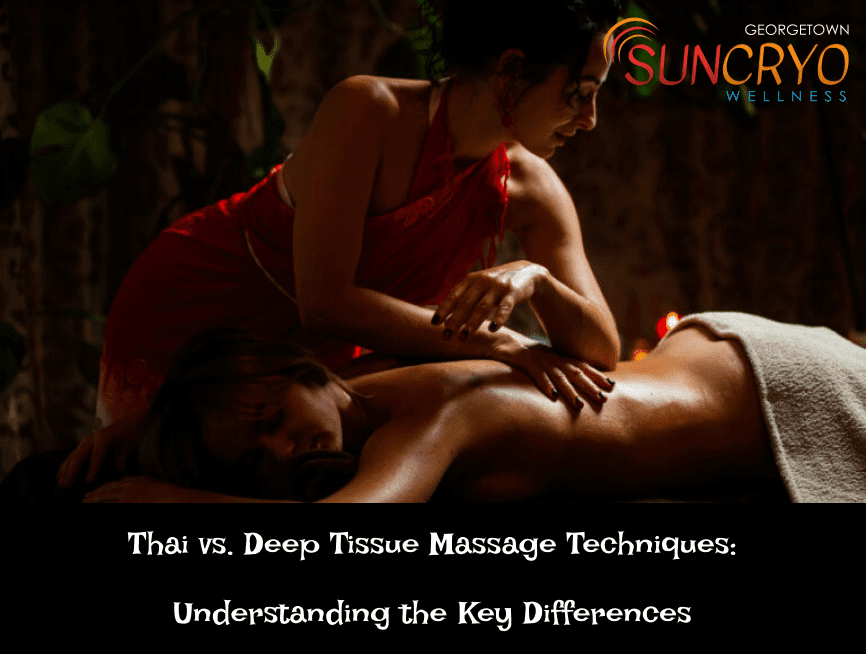Thai vs. Deep Tissue Massage

When it comes to indulging in the world of massages, two prominent techniques that often stand out are the Thai and Deep Tissue massages. Both offer distinctive benefits and approaches, tailored to address various physical concerns and provide relaxation. In this comprehensive guide, we will delve into the core dissimilarities between these two popular massage techniques, aiding you in making an informed decision about which might suit your needs best.
Understanding Thai Massage
Thai massage is a traditional healing practice rooted in ancient Thai medicine. It involves a blend of acupressure, gentle stretching, and assisted yoga postures. The masseuse uses their hands, elbows, knees, and feet to apply pressure to specific points on the body, aiming to release tension and improve energy flow along the sen lines. The recipient remains fully clothed during this massage.
This technique primarily focuses on enhancing flexibility, improving circulation, and relieving joint stiffness. Through rhythmic compressions and passive stretching, Thai massage aims to align the body’s energies while promoting a deep sense of relaxation and balance.
Exploring Deep Tissue Massage
On the other hand, Deep Tissue Massage centers on addressing musculoskeletal issues and chronic tension. This technique involves applying firm pressure and slow strokes to target deeper layers of muscles and connective tissues. Skilled therapists use their knuckles, fists, elbows, and forearms to alleviate tightness and break down adhesions in the muscle fibers.
Deep Tissue Massage aims to release chronic patterns of tension, focusing on specific problem areas to reduce pain and restore normal movement. Unlike Thai massage, recipients usually disrobe partially or fully to allow the therapist better access to the muscles.
Key Differences between Thai and Deep Tissue Massage Techniques
1. Technique and Application
Thai massage incorporates stretching and acupressure techniques, focusing on energy lines to promote overall well-being. In contrast, Deep Tissue Massage targets deeper layers of muscles and connective tissues through sustained pressure and strokes.
2. Intensity and Pressure
While both massages offer therapeutic benefits, the intensity varies significantly. Thai massage involves gentle stretches and rhythmic pressure, whereas Deep Tissue Massage applies firmer, deeper pressure to release chronic muscle tension.
3. Clothing
During a Thai massage, clients remain fully clothed in loose, comfortable attire, enabling ease of movement during stretches. Conversely, for Deep Tissue Massage, clients usually disrobe partially or fully to facilitate access to the targeted muscle groups.
4. Goals and Benefits
Thai massage aims to balance the body’s energies, enhance flexibility, and improve circulation, promoting relaxation and revitalization. Deep Tissue Massage, however, targets specific muscle groups to alleviate chronic pain, reduce stiffness, and restore mobility.
Choosing the Right Massage for You
When deciding between Thai and Deep Tissue massages, consider your specific needs and desired outcomes. If you seek overall relaxation, improved flexibility, and energy alignment, Thai massage might be ideal. On the contrary, if you’re grappling with chronic muscle tension or seeking relief from specific aches and pains, deep-tissue massage could be more beneficial.
Conclusion
In summary, both Thai and Deep Tissue massages offer unique therapeutic benefits, catering to distinct wellness goals. Understanding the fundamental differences between these techniques empowers individuals to choose the massage modality that aligns best with their physical requirements and preferences.
For a rejuvenating experience that aligns with your specific needs, consult with a skilled massage therapist who can further guide you in selecting the most suitable technique tailored to your well-being.
